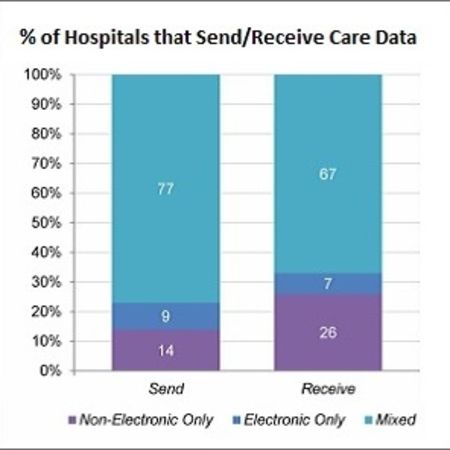Electronic exchange of health information amongst healthcare providers has important implications for patient safety and care coordination. However, only 9 percent of hospitals use only electronic means of exchanging patient summary of care records with outside sources, according to a report from the Office of the National Coordinator for Health IT (ONC).
The report summarises results of a nationwide survey of non-federal acute care hospitals conducted by the American Hospital Association. Survey results show that, in 2014, a majority of hospitals used a combination of electronic and non-electronic means to send (77 percent) and receive (67 percent) summary of care records to/from outside sources. In addition, 26 percent of hospitals received summary of care records in non-electronic format only (eg, mail, fax or eFax).
“Despite the potential benefits of electronic exchange, a majority of hospitals used a mixture of paper and electronic methods to exchange information,” notes the ONC report. “This might be due to exchange partners’ limited capability to receive information, which was considered by hospitals to be the top barrier to interoperability.”
The survey also found that, while most hospitals (78 percent) sent summary of care records, only about half (56 percent) received these data. Interestingly, only 4 in 10 hospitals reported they can integrate information from patient summary of care records into their EHRs, which according to ONC Interoperability and Exchange Portfolio Manager Erica Galvez “poses challenges to clinical workflow and information usability.”
The ONC report also notes that long-term care and behavioural healthcare providers, in particular, have limited capabilities to electronically exchange data with outside providers.
“Hospitals’ rates of both sending and receiving patient summary of care records to and from long-term care and behavioural healthcare providers were considerably lower than electronic exchange with outside hospitals and ambulatory care providers,” the ONC report says.
Additionally, few hospitals (10 percent) reported that they do not typically share data with outside providers. This finding has implications for health information blocking, which has also been identified as a barrier to interoperability by ONC.
Source and image credit: Office of the National Coordinator for Health IT
The report summarises results of a nationwide survey of non-federal acute care hospitals conducted by the American Hospital Association. Survey results show that, in 2014, a majority of hospitals used a combination of electronic and non-electronic means to send (77 percent) and receive (67 percent) summary of care records to/from outside sources. In addition, 26 percent of hospitals received summary of care records in non-electronic format only (eg, mail, fax or eFax).
“Despite the potential benefits of electronic exchange, a majority of hospitals used a mixture of paper and electronic methods to exchange information,” notes the ONC report. “This might be due to exchange partners’ limited capability to receive information, which was considered by hospitals to be the top barrier to interoperability.”
The survey also found that, while most hospitals (78 percent) sent summary of care records, only about half (56 percent) received these data. Interestingly, only 4 in 10 hospitals reported they can integrate information from patient summary of care records into their EHRs, which according to ONC Interoperability and Exchange Portfolio Manager Erica Galvez “poses challenges to clinical workflow and information usability.”
The ONC report also notes that long-term care and behavioural healthcare providers, in particular, have limited capabilities to electronically exchange data with outside providers.
“Hospitals’ rates of both sending and receiving patient summary of care records to and from long-term care and behavioural healthcare providers were considerably lower than electronic exchange with outside hospitals and ambulatory care providers,” the ONC report says.
Additionally, few hospitals (10 percent) reported that they do not typically share data with outside providers. This finding has implications for health information blocking, which has also been identified as a barrier to interoperability by ONC.
Source and image credit: Office of the National Coordinator for Health IT
Latest Articles
healthmanagement, electronic health records, EHR, American Hospital Association, interoperability, health IT
Electronic exchange of health information amongst healthcare providers has important implications for patient safety and care coordination. However, only 9 percent of hospitals use only electronic means of exchanging patient summary of care records with o



























